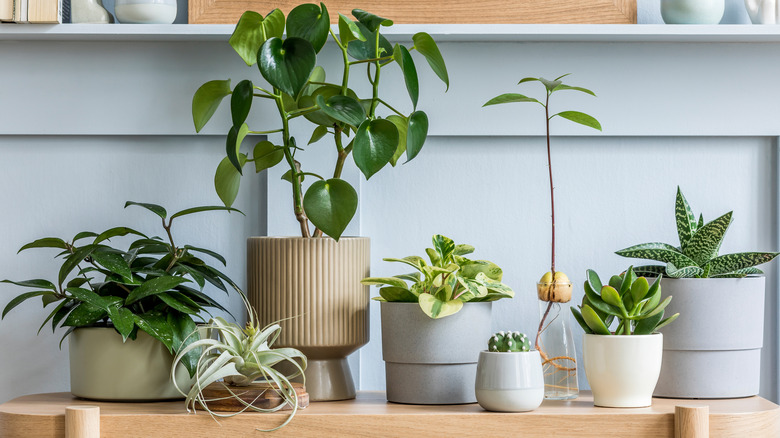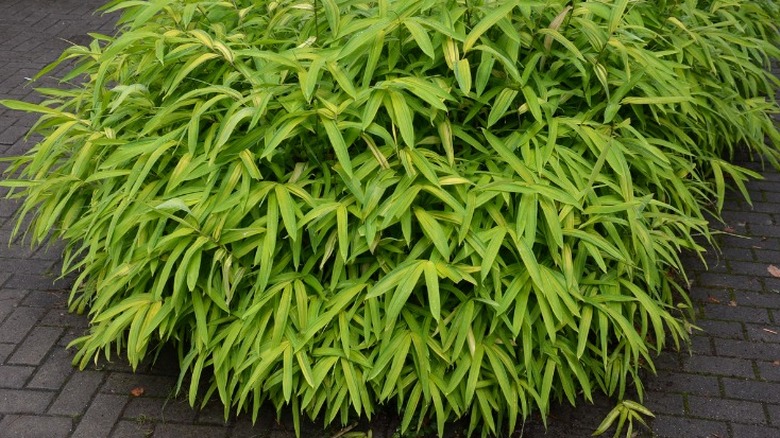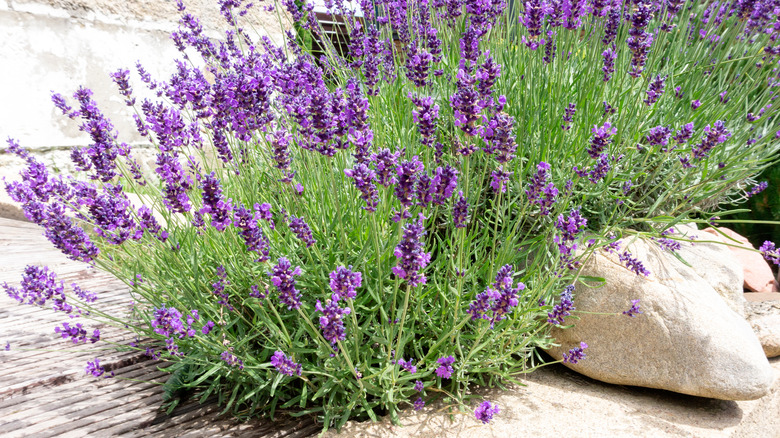15 Plants For Your Garden That Will Bring Positive Energy
Need a natural boost of energy? You might look to your garden for a new-found elevated vibe. From green plant life and herbs to vibrantly colored flowers and succulents, plants may be the superheroes of optimism. According to Psychology Today, gardening in general is an uplifting activity that has the potential to heal and inspire. Whether it's establishing an herb garden or surrounding yourself in a beautiful, meditative space, cultivating a garden offers limitless opportunities to find enlightenment through plant life. What's their secret? Through the process of photosynthesis, all plants, including algae and certain microorganisms, can transform light into energy. While plants produce oxygen through this natural conversion, some may contain superlative superpowers compared to others.
So, which plants possess the ultimate vitality? Whether colorful or green, edible or fragrant, plants have the power to improve our lives through their lively presence. Flowers that feature colors of orange, yellow, pink, and red will significantly enhance your garden space while green plants that showcase lustrous foliage may enrich it, including likely health benefits from various herbs. Whichever plants allure you, there's an inspiring variety of vegetation to choose from. Keep reading to discover some of the most energetic plants to include in your garden.
1. Aloe vera
Native to Africa, the aloe vera plant (Aloe barbadensis) is an eye-catching, medicinal succulent that offers immediate skin relief from the aloe secretions when broken open. With prickly edges and lush green flesh, aloe vera is a hardy, giving plant that occasionally blooms when planted outdoors. Use a well-draining potting mixture specifically designed for cacti and succulents for ultimate growth, including perlite, lava rock, and bark (via Almanac).
Bloom Season: March to May
USDA Growing Zone: 7 to 9
Growing Conditions: 6 hours of indirect light
Soil Type: Well-drained
Size: 1 to 2 feet tall
2. Bamboo
Whether tall and sturdy, or short and bushy, bamboo (Bambusa vulgaris) comes in various sizes. It emanates a tranquil yet buoyant aura with its smooth culms and vivacious green color. Ultimately a grass, bamboo grows and spreads rapidly as new shoots emerge each spring, and it may even flower after several decades, per Down To Earth. Often a symbol of fortune and prosperity, bamboo acts well as a privacy wall.
Bloom Season: Spring
USDA Growing Zone: 8 to 10
Growing Conditions: 6 hours of direct light
Soil Type: Moist, well-drained
Size: Average height 15 to 40 feet
3. Basil
Lush and green, basil (Ocimum basilicum) is a fragrant and versatile culinary herb that has been utilized in numerous universal dishes for thousands of years. Its potent yet delicate leaves contain antioxidants while providing other various health benefits like fighting inflammation, stress, and infections. With two main varieties, Sweet and Thai, basil thrives during the warmer months and may prosper longer in tropical climates (per When Is The Season).
Bloom Season: June to September
USDA Growing Zone: 10 and 11
Growing Conditions: 6 to 8 hours of full sun
Soil Type: Moist, rich, well-drained
Size: 12 to 24 inches tall
4. Cactus
With the protective appearance of needles, the cactus plant, part of the Cactaceae family, has the superpower to alleviate negativity and anxiety, including the absorption of electromagnetic energy (via India Times). Cacti are legendary for their progressive vibes and maternal-like love and strength. Highly easy to care for, cacti can be cold hardy, yet may typically thrive well annually in a warm outdoor climate amidst gravel and pumice.
Bloom Season: Spring
USDA Growing Zone: 6 to 9, some 4
Growing Conditions: 6 hours of direct sunlight
Soil Type: Gritty, well-drained
Size: 2 to 3 feet high
5. Chrysanthemums
A fall favorite, chrysanthemums (Chrysanthemum x morifolium), or mums, come in numerous varieties like flexed and pompom. Native to East Asia, mums radiate positive energy through their vibrant, colorful blooms like orange, red, and yellow. You might plant them to decorate borders, as they transition well from summer to harvest time, sometimes into the winter months, per Gardeners World.
Bloom Season: September to November
USDA Growing Zone: 5 to 10
Growing Conditions: Up to 6 hours of sun, partial shade
Soil Type: Moist, well-drained
Size: 2 to 3 feet tall by 4 to 6 inches wide
6. Daffodils
A friend to spring, the daffodil (Narcissus) emerges with bountiful blooms each year. A symbol of cheerfulness and rebirth, the European perennial is a stunning addition to entryways and flower boxes, as colors vary from pink to orange, yellow, and white. Commonly sold as bulbs, plant daffodils in the mid-fall to early winter, per Longfield Gardens.
Bloom Season: Spring
USDA Growing Zone: 3 to 8
Growing Conditions: 6 hours of direct sun
Soil Type: Rich, moist, well-drained
Size: 6 to 30 inches tall
7. Golden pothos
A common houseplant, golden pothos (Epipremnum aureum) can thrive outdoors in pots or in hanging baskets, as seen above. Joyful and buoyant, the Devil's Ivy is known for promoting good luck and happiness with its lively greenish-yellow leaves. An exotic climbing vine from the islands of French Polynesia, golden pothos is a low-maintenance, resilient plant that can extend up to 30 feet (via The Practical Planter).
Bloom Season: Flower only with maturation
USDA Growing Zone: 10 to 12
Growing Conditions: Bright, indirect light
Soil Type: Well-drained
Size: Average length 10 feet with leaves 4 to 8 inches long
8. Hawaiian Ti
Pretty in pink, Hawaiian Ti (Cordyline fruticose) is part of the asparagus family and originates from Southeast Asia and Oceania. Ti, or Ki, features sturdy pinkish-green leaves originally used to make Hawaiian leis as a symbol of good fortune and health. Occasionally, the exotic flowering plant may bloom when planted outdoors with fragrant pink or white clusters, including red berries, per Trees. The plant's vivid magenta-like color contrasts well with palm trees.
Bloom Season: Spring
USDA Growing Zone: 10 to 12
Growing Conditions: Bright, indirect light
Soil Type: Rich, well-drained
Size: 3 to 4 feet
9. Jade
With smooth, round leaves that resemble green coins, jade (Pilea peperomioides) is an elegant and prosperous plant. A low-maintenance succulent, the jade plant will brighten spirits indoors or out with its rich green presence. You can propagate jade in your garden from a few branches. It likes gritty, rocky sand that contains tiny pebbles or stones, meaning there's no need for earthy, wet soil, per Get Busy Gardening.
Bloom Season: November to February
USDA Growing Zone: 10 and 11
Growing Conditions: 6 hours of indirect light
Soil Type: Well-drained, sandy, coarse
Size: Up to 5 feet tall
10. Lavender
Aromatic and lovely, lavender, or Lavandula, secretes one of the most invigorating herbal scents utilized in culinary and medicinal arenas. Known to soothe, the delicate purple shrub stems from the Mediterranean and grows abundantly in the summer while appearing most attractive as a border or hedge. Besides its versatile health benefits, lavender also repels bugs and pests in the garden like mosquitos and ticks, per Flower Works.
Bloom Season: July to August
USDA Growing Zone: 5 to 9
Growing Conditions: Full sun, 6 hours plus
Soil Type: Well-drained, slightly alkaline
Size: 20 to 40 inches tall and wide
11. Peony
The perfumed peony (genus Paeonia) is a springtime favorite and signifies love, compassion, and bliss. Native to various northern regions of the world, the perennial plant comes in three different types with some appearing more like a woody tree or shrub, including the Itoh (intersectional), per Garden Design. Choose from gorgeous colors like romantic pink, pure white, passionate red, or sunny yellow.
Bloom Season: April to June
USDA Growing Zone: 2 to 8
Growing Conditions: 6 hours of full sun, partial shade
Soil Type: Well-drained
Size: 4 to 7 feet tall by 4 to 5 feet wide
12. Mint
Refreshing and invigorating, mint (Mentha) is used in various drinks, smoothies, and various dishes. Known for its fresh bite, mint is part of the Lamiaceae family and has been a medicinal herb since ancient Egyptian times — its top health benefit is aiding digestion (via JSTOR Daily). You might also try peppermint (Mentha piperita) or spearmint (Mentha viridis) for a slight variation in sweetness.
Bloom Season: June to September
USDA Growing Zone: 3 to 8
Growing Conditions: Full sun, partial shade
Soil Type: Moist, well-drained (with compost)
Size: 12 to 18 inches tall by 18 to 4 inches wide
13. Rosemary
Whether potted or planted, rosemary (Salvia rosmarinus) can grow abundantly outdoors and looks lovely along borders or as hedges. Rich and earthy, rosemary is an evergreen shrub often used for culinary purposes that also features medicinal benefits, including boosting better brain function and lowering stress. Rosemary may bloom with bluish to white flowers and you should prune mid-summer to early fall before the first chill (via The Gardening Cook).
Bloom Season: Spring to early summer
USDA Growing Zone: 7 to 10
Growing Conditions: Full sun, partial shade
Soil Type: Dry, sandy, loamy
Size: 12 to 18 inches tall by 18 to 4 inches wide
14. Sage
One of the most nutrient-dense herbs, sage (Salvia officinalis) features high amounts of vitamin K, which supports your bone, dental, and heart health (via Healthline). Original to the northern coastlines of the Mediterranean, sage is part of the mint (Lamiaceae) family and radiates wisdom and strength. You can pick its virtuous leaves annually, although summer is when the leaves possess the most flavor.
Bloom Season: Summer
USDA Growing Zone: 4 to 10
Growing Conditions: 6 hours of full sun
Soil Type: Sandy, loamy, well-drained
Size: Up to 2 ½ feet tall
15. Poinsettia
Red and festive, poinsettia (Euphorbia pulcherrima) is typically showcased during the holidays, although, with the right care, it can thrive in your garden annually, especially in warmer climates. Native to Mexico and Central America, the tropical poinsettia loves nightfall in preparation for new buds to bloom, according to NM State, as it is suited for those long, dark winter nights.
Bloom Season: Late September to early October
USDA Growing Zone: 9 to 11
Growing Conditions: Up to 6 hours of indirect sunlight, approximately 14 hours of darkness
Soil Type: Well-drained, slightly acidic
Size: 10 to 15 feet tall















